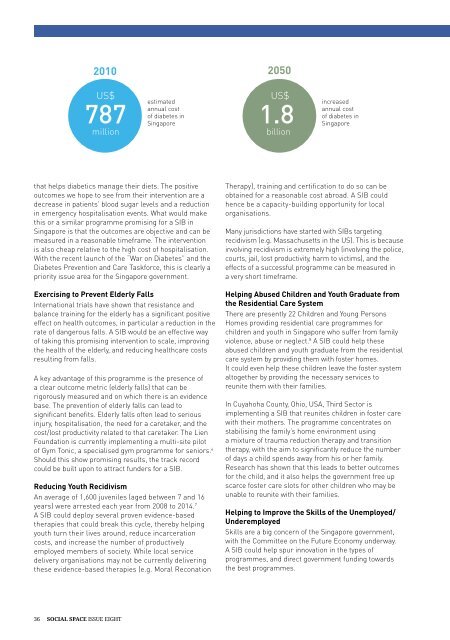Social Space (Issue 8, 2016-2017) - The Social Finance Issue
Since its debut in 2008, Social Space, the bi-annual flagship publication of the Lien Centre for Social Innovation at Singapore Management University, has provided a platform for local and international practitioners and thought leaders to share their perspectives on social innovation and entrepreneurship. Available in print and online (http://www.socialspacemag.org).
Since its debut in 2008, Social Space, the bi-annual flagship publication of the Lien Centre for Social Innovation at Singapore Management University, has provided a platform for local and international practitioners and thought leaders to share their perspectives on social innovation and entrepreneurship. Available in print and online (http://www.socialspacemag.org).
You also want an ePaper? Increase the reach of your titles
YUMPU automatically turns print PDFs into web optimized ePapers that Google loves.
2010 2050<br />
US$<br />
estimated<br />
annual cost<br />
of diabetes in<br />
787 Singapore 1.8<br />
million<br />
US$<br />
billion<br />
increased<br />
annual cost<br />
of diabetes in<br />
Singapore<br />
that helps diabetics manage their diets. <strong>The</strong> positive<br />
outcomes we hope to see from their intervention are a<br />
decrease in patients’ blood sugar levels and a reduction<br />
in emergency hospitalisation events. What would make<br />
this or a similar programme promising for a SIB in<br />
Singapore is that the outcomes are objective and can be<br />
measured in a reasonable timeframe. <strong>The</strong> intervention<br />
is also cheap relative to the high cost of hospitalisation.<br />
With the recent launch of the “War on Diabetes” and the<br />
Diabetes Prevention and Care Taskforce, this is clearly a<br />
priority issue area for the Singapore government.<br />
Exercising to Prevent Elderly Falls<br />
International trials have shown that resistance and<br />
balance training for the elderly has a significant positive<br />
effect on health outcomes, in particular a reduction in the<br />
rate of dangerous falls. A SIB would be an effective way<br />
of taking this promising intervention to scale, improving<br />
the health of the elderly, and reducing healthcare costs<br />
resulting from falls.<br />
A key advantage of this programme is the presence of<br />
a clear outcome metric (elderly falls) that can be<br />
rigorously measured and on which there is an evidence<br />
base. <strong>The</strong> prevention of elderly falls can lead to<br />
significant benefits. Elderly falls often lead to serious<br />
injury, hospitalisation, the need for a caretaker, and the<br />
cost/lost productivity related to that caretaker. <strong>The</strong> Lien<br />
Foundation is currently implementing a multi-site pilot<br />
of Gym Tonic, a specialised gym programme for seniors. 6<br />
Should this show promising results, the track record<br />
could be built upon to attract funders for a SIB.<br />
Reducing Youth Recidivism<br />
An average of 1,600 juveniles (aged between 7 and 16<br />
years) were arrested each year from 2008 to 2014. 7<br />
A SIB could deploy several proven evidence-based<br />
therapies that could break this cycle, thereby helping<br />
youth turn their lives around, reduce incarceration<br />
costs, and increase the number of productively<br />
employed members of society. While local service<br />
delivery organisations may not be currently delivering<br />
these evidence-based therapies (e.g. Moral Reconation<br />
<strong>The</strong>rapy), training and certification to do so can be<br />
obtained for a reasonable cost abroad. A SIB could<br />
hence be a capacity-building opportunity for local<br />
organisations.<br />
Many jurisdictions have started with SIBs targeting<br />
recidivism (e.g. Massachusetts in the US). This is because<br />
involving recidivism is extremely high (involving the police,<br />
courts, jail, lost productivity, harm to victims), and the<br />
effects of a successful programme can be measured in<br />
a very short timeframe.<br />
Helping Abused Children and Youth Graduate from<br />
the Residential Care System<br />
<strong>The</strong>re are presently 22 Children and Young Persons<br />
Homes providing residential care programmes for<br />
children and youth in Singapore who suffer from family<br />
violence, abuse or neglect. 8 A SIB could help these<br />
abused children and youth graduate from the residential<br />
care system by providing them with foster homes.<br />
It could even help these children leave the foster system<br />
altogether by providing the necessary services to<br />
reunite them with their families.<br />
In Cuyahoha County, Ohio, USA, Third Sector is<br />
implementing a SIB that reunites children in foster care<br />
with their mothers. <strong>The</strong> programme concentrates on<br />
stabilising the family’s home environment using<br />
a mixture of trauma reduction therapy and transition<br />
therapy, with the aim to significantly reduce the number<br />
of days a child spends away from his or her family.<br />
Research has shown that this leads to better outcomes<br />
for the child, and it also helps the government free up<br />
scarce foster care slots for other children who may be<br />
unable to reunite with their families.<br />
Helping to Improve the Skills of the Unemployed/<br />
Underemployed<br />
Skills are a big concern of the Singapore government,<br />
with the Committee on the Future Economy underway.<br />
A SIB could help spur innovation in the types of<br />
programmes, and direct government funding towards<br />
the best programmes.<br />
36 <strong>Social</strong> <strong>Space</strong> ISSUE EIGHT


